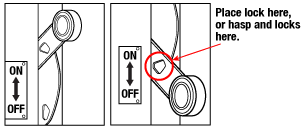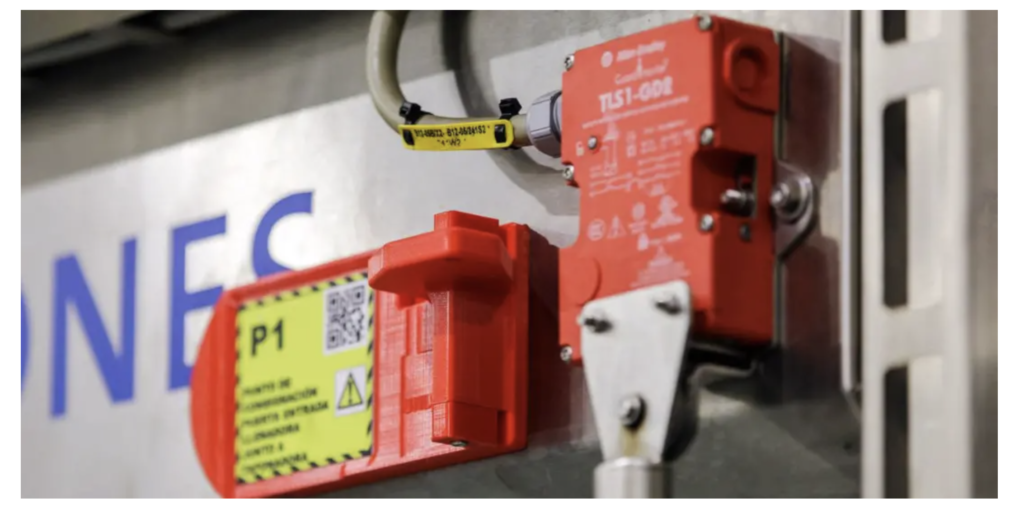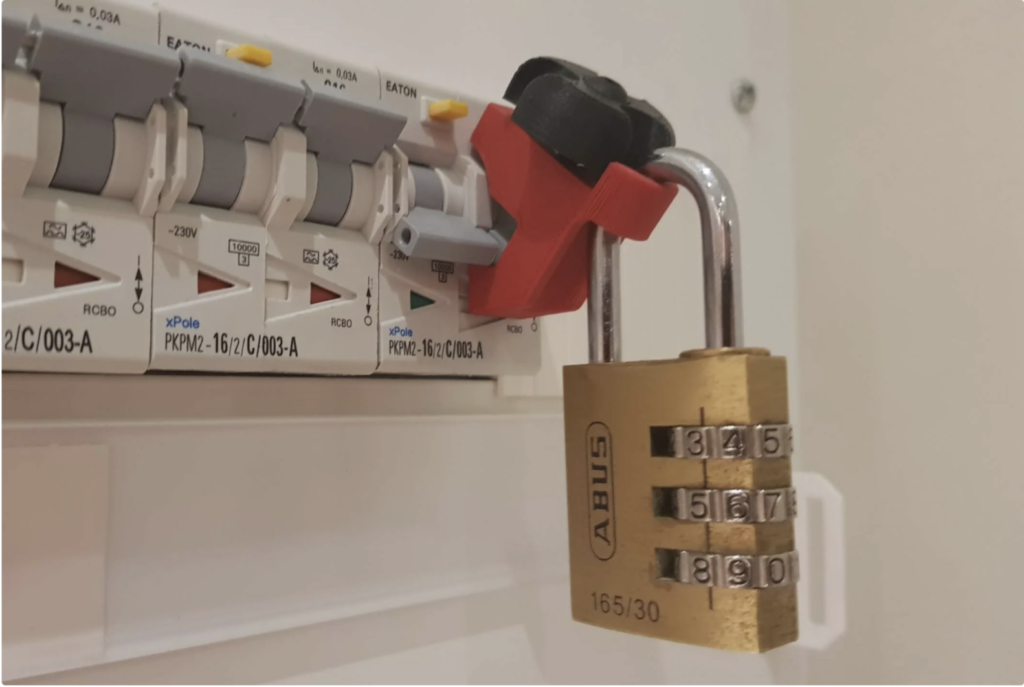Previously I’ve written that 3D printing is industrial strength duck tape for your business. Through seeing our technology as an improvisational tool that can be used to solve problems, I’ve really been able to unlock a lot of value for customers. But, this thinking also obscures some valuable trends. By thinking of every improvisational 3D printed part as duck tape, you obscure the fact that very interesting developments are already occurring.
One of these developments that I was blithely ignorant of was the use of 3D printing as Lockout-Tagout Tooling (LOTO). LOTO are physical locks used to disable hazardous machines so they can not be restarted without the proper procedure being followed. This could perhaps be a temporary measure. keeping people from accidentally or accidentally-on-purpose starting a dangerous machine while it is being repaired. Or it could be permanent, because it is an industry-wide practice, mandated by law or safer this way. Usually, LOTO tools are placed on circuit breakers and must keep the machine from being started unless a necessary procedure is followed.

The Canadian Centre for Occupational Health and Safety explains it well,
“[L]ockout is the isolation of energy from the system (a machine, equipment, or process) which physically locks the system in a safe mode. The energy-isolating device can be a manually operated disconnect switch, a circuit breaker, a line valve, or a block (Note: push buttons, selection switches and other circuit control switches are not considered energy-isolating devices). In most cases, these devices will have loops or tabs which can be locked to a stationary item in a safe position (de-energized position). The locking device (or lockout device) can be any device that has the ability to secure the energy-isolating device in a safe position.
“Tag out is a labelling process that is always used when lockout is required. The process of tagging out a system involves attaching or using an information tag or indicator (usually a standardized label) that includes the following information:
- Why the lockout/tag out is required (repair, maintenance, etc.).
- Time of application of the lock/tag.
- The name of the authorized person who attached the tag and lock to the system.
“Note: ONLY the authorized individual who placed the lock and tag onto the system is the one who is permitted to remove them. This procedure helps make sure the system cannot be started up without the authorized individual’s knowledge.”
Therefore, it has to be a combination of physically blocking a device along with a procedure. I had seen some of this happening, but wasn’t aware of just how useful or how widespread LOTO was. I was, I’m ashamed to admit, wholly unfamiliar with the term until Ultimaker’s Matt Griffin asked me about it. Ultimaker has a case showing you how such a part is being used at Heineken.

Initially, I filed this as yet another duck tape-type application, but it kept cropping up again and again. I refused to see the light and chalked it up to the Baader Meinhof phenomenon or frequency illusion—that is, a cognitive bias whereby an interesting, new term will all of a sudden appear everywhere upon learning it. It was only recently when I finally realized just how important LOTO tooling could be for 3D printing.
In two conversations with Matt Griffin, I discussed adopting 3D printing for the food and beverage industry and within large organizations. Generally, we have seen several approaches to introducing 3D printing in large companies. The top-down approach is where senior management realizes through an article in the Economist that 3D printing will be of crucial import to their business. Enthusiastic young MBA types fan out and come back with a report and the organization as a whole adopts 3D printing because it is strategic.
To my knowledge, this has only happened at Stryker, Henkel, and SpaceX. Most of the time, these approaches fail due to institutional resistance. We’re essentially ruining lives of production workers with some newfangled stuff that they’re not incentivized to adopt.
A second, more successful implementation is the bottom-up approach, whereby an employee on the shop floor surreptitiously prints a part on their desktop machine and it is used on the shop floor, leading to broader adoption for these duck tape-like applications later.
A third way is a project-based approach, which I refer to as the “ski tractor approach”, discussed in more detail in this podcast episode.

Beautiful universal fuse locks by Creolucious on Thingiverse and Prusaprinters.
What we’ve seen about the bottom-up approach is that 3D printing acts as a problem-solver for a non-mission-critical part that helps the company go about its business. 3D printing is not the bull in the china shop, but the helping hand that makes your job easier. Our technology is doing so in a less expensive way than comparable solutions and we’re faster as well!
This is precisely why jigs and fixtures have been so important to us. Jigs and fixtures are a gateway applications to full-scale manufacturing with 3D printing and also broader corporate manufacturing. They are as slow as you want, as fast as you need, and a cheap way for companies to familiarize themselves with 3D printing. The beauty of this approach is that it raises through the shop floor, percolating throughout the organization, rather than being forced onto everyone from above.
LOTO tooling is just such an application. But, it gets better, because the person whose life we can make easier is the safety manager. And safety managers hate us. We want to put argon in their factories, which can suffocate everyone. We want to put kilos of titanium powder in their buildings, which can explode or catch fire. We want to spread god-knows-what-kinds-of-noxious fumes and resins in their production locations, as well. We think we’re there to help, but we’re barbarians at the gate for a safety manager. They’ve worked for years to make the floors clean enough to eat off of and keep out all the bad chemicals and hand-cutting-off machines. Here we are with our wonky, explod-y technologies.

Great little circuit breaker ring by Soeselheinin on Thingiverse.
But, now, we can help those responsible for safety by creating the perfect LOTO for every single machine or device that they have and we can do so inexpensively, as well. This means that, early on in sales engagement, we can already start to work with the safety people—rather than ride roughshod over their “infinite days without injury” dreams. We can help them to do their jobs by making any manner of safe LOTO tools. This will help us in properly engaging the client and help the client in properly understanding us. In addition to jigs and fixtures, we now have another gateway application to help manufacturing firms discover 3D printing. It’s beautiful.
Subscribe to Our Email Newsletter
Stay up-to-date on all the latest news from the 3D printing industry and receive information and offers from third party vendors.
You May Also Like
APWORKS Expands Scalmalloy 3D Printing with Farsoon and CNPC Partnerships
In the lead up to Formnext 2024, Airbus subsidiary APWORKS has teamed up with Farsoon Technologies and CNPC Powder to expand the production and application of Scalmalloy, APWORKS’ high-strength, corrosion-resistant...
3D Printer OEM Axtra3D Raises Nearly $10M in Series A
Axtra3D, an original equipment manufacturer (OEM) of 3D printers leveraging the company’s patented Hybrid Photosynthesis (HPS) technology, has received another $4.5 million in Series A financing, bringing its total Series...
Caracol AM to Launch its First Metal 3D Printer at Formnext 2024
Caracol AM, a US-Italian original equipment manufacturer (OEM) of large-format additive manufacturing (AM) systems, has announced the launch of the company’s first metal printer, Vipra AM. A directed energy deposition...
ADDIMETAL to Debut First French Metal Binder Jetting 3D Printer at Formnext 2024
ADDIMETAL, a French original equipment manufacturer (OEM) of additive manufacturing (AM) hardware, will debut its first product, the K2-2 metal binder jetting (MBJ) printer, at Formnext 2024 in Frankfurt, Germany...






































